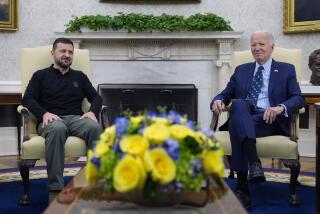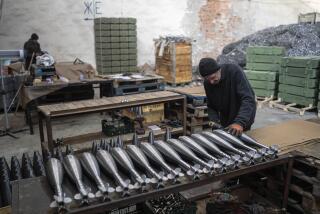A Military That Lacks One Crucial Element: Weapons
- Share via
KABUL, Afghanistan — On a sunny day in September, U.S. special operations troops combing a complex of mud-and-wattle buildings in eastern Afghanistan surrounded the compound of a suspected Taliban sympathizer. What they found inside astounded them: stacks of 107-millimeter rockets, Russian rocket launchers, Chinese machine guns, nearly 20,000 rounds of antiaircraft ammunition, even a Panzerfaust, a World War II-era German antitank weapon.
The massive arms cache filled three “jingle trucks,” heavy transports decorated with intricate grillwork and metal chimes.
The next day, a U.S. military spokesman declared the weapons haul “off the market” and said most would be destroyed. Guns and ammo deemed functional would be handed over to the Afghan National Army, a multiethnic fighting force that is being created with U.S. help to support democracy in Afghanistan.
The new national army is a key to wresting control of the country from warlords, and supplying the fledgling force with weapons is an easy way to help. Records maintained by the U.S. military dating to last October show that the national army has received confiscated mortars, antiaircraft machine guns, shoulder-fired rocket launchers and 1,185 assault rifles--all in good working condition--courtesy of the American military.
There’s just one problem: Hardly any of the weapons have reached the fledgling force.
In fact, Afghanistan’s national army has faced chronic weapons shortages in a country saturated with 10 million small arms, according to United Nations estimates. Weapons seized by U.S. forces and earmarked for the national army find their way into regional militias instead. And the Afghan Defense Ministry, itself dominated by a factional army, has been reluctant to open its weapons stocks to the fledgling force.
Even as the country stumbles toward peace after 23 years of war, military hardware remains the primary currency of power in Afghanistan. By that measure, the feckless national army, along with the civilian authority it represents, is bankrupt, while the warlord armies are rolling in it.
American troops routinely stumble across arms caches during exercises in the Afghan countryside; and just as routinely, U.S. officials announce that the best of the weapons are being turned over to the national army. However, closer examination reveals that the usable portions of the arsenals are instead distributed among the militiamen who are with American soldiers when the weapons are discovered.
Col. Roger King, a U.S. military spokesman, said that whatever is left over after local factions are outfitted is handed over to the national army, but that “not a lot is making it.”
According to Martha Brill Olcott, senior associate at the Carnegie Endowment for International Peace, the United States is hampering the development of civilian authority by supporting warlords in a bid to roust Al Qaeda and Taliban remnants.
“One of the problems with dealing with warlords is that they behave in the way that their name implies,” Olcott said. “The warlords are unlikely to go quietly into the night, especially after topping up their weapons stores, thanks to the generosity of the war on terrorism’s main supporters.”
U.S. forces have been providing support for factional militia groups since the ground war in Afghanistan began late last year.
“Part of the American game is to play with the local commanders, give them big money and strengthen their power locally,” said one Western diplomat in Kabul, who requested anonymity because of the sensitivity of the issue. “For that money, weapons are procured easily. Those weapons are too often being used not against Al Qaeda and the Taliban, but against political opponents and enemies.”
One of the U.S. military’s key allies in Afghanistan has been Mohammed Qassim Fahim, a top commander of the Northern Alliance, who became defense minister after the Taliban regime fell. At the same time that Fahim holds the nation’s highest civilian defense portfolio, he heads a powerful ethnic Tajik militia from the Panjshir Valley, north of the capital, which dominates the Defense Ministry.
“Fahim is fiercely protective of his power, and he sees [the national army] as a threat,” said Paul Burton, South Asia editor for Jane’s Sentinel, a defense publication. “It’s small now, but the thing to bear in mind, if you follow the [national army] through to its natural end, is that it entails the end of Fahim’s force.”
Perhaps because of the conflict between his status as a faction leader and the more democratic aims of the national army, Fahim has been reluctant to support it; when the first battalion began training in April, weapons that were supposed to come from the Defense Ministry never arrived.
“It was like pulling teeth from a mouth that didn’t have any teeth,” said Lt. Col. Kevin McDonnell, commander of the U.S. Special Forces troops who are helping train the new army. “I had soldiers literally going out and robbing caves to recover weapons and ammo because we weren’t getting anything” from the Defense Ministry.
With the national army receiving little support from the Afghan military establishment, Romania donated 1,000 reconditioned Kalashnikovs to the training academy in April. Since then, other Eastern European countries have jumped on the arms-donation bandwagon, with Bulgaria handing over 400 used Kalashnikovs, along with a batch of new 73-millimeter recoilless rifles. In addition, Russia, Albania, Slovenia and Hungary have expressed interest in making contributions, and Ukraine has earmarked nearly 1,000 tons of guns and ammunition. The national army will be happy to take delivery of the donations, which are said to range from rifles to helicopters, but the Defense Ministry is reluctant to release the hardware.
“We don’t want to give these new weapons to the national army because we have enough weapons all over Afghanistan,” said Deputy Defense Minister Atiqullah Barialai, who is in charge of overseeing the creation of the national army.
Barialai said imports of new weapons will be held in storage pending a round of general disarmament. Once enough firearms have been collected, the donated weapons will be distributed to the national army, he said.
One European ambassador is skeptical that the weapons committed to the national army will make it into the hands of recruits.
“They will go to the Ministry of Defense, and presumably into Panjshiri units,” the ambassador said.
Because of concerns about where the weapons will end up, some countries have earmarked donations for the national army training center only. However, once cadets graduate, they leave their weapons behind, and it is up to Fahim to outfit the national troops with combat arms.
Some observers believe that Fahim is warming to the idea of the national army, in part because of pressure from Western powers and Afghan President Hamid Karzai to project the air of a national politician. Fahim has taken to wearing a three-piece suit and has spoken in favor of the national army in public speeches and private meetings alike.
“In the beginning, he was opposed to the idea ... but his stated position has transformed,” says a Western intelligence analyst in the capital, Kabul.
“Did it change because it was something he can manipulate? Or because he has ambitions beyond his parochial interest in keeping the military in his corner?”
Compelling Afghanistan’s warriors to sign on with civilian rule, leaving defense matters to the national army, is crucial to peace in Afghanistan.
As Special Forces commander McDonnell put it, “This is a must-win deal.”
More to Read
Sign up for Essential California
The most important California stories and recommendations in your inbox every morning.
You may occasionally receive promotional content from the Los Angeles Times.













